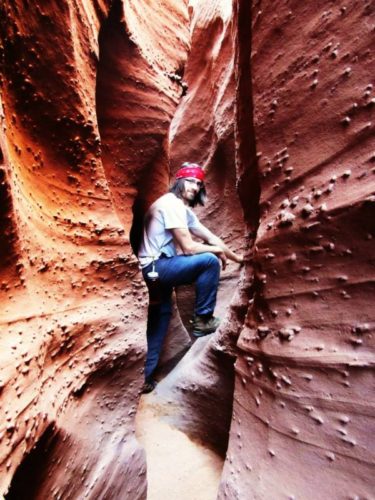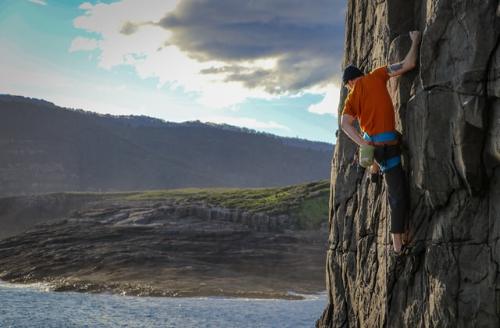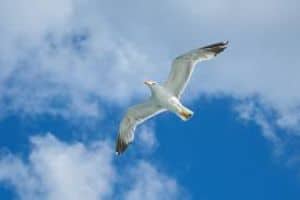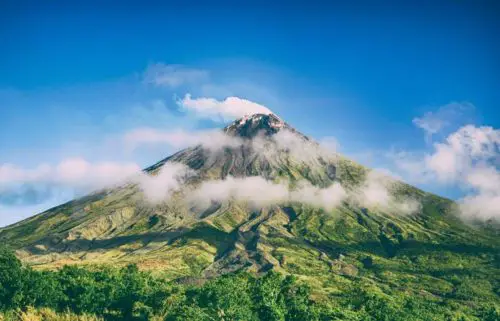
Bouldering Along the Oregon Coast (with a Hint of Deep Water Soloing)
Adventure Is Calling

Clamber over rocks and crazy water-worn edges, conquer the boulders of the Oregon coastline to declare yourself the “King of the Rock”—and enjoy the majestic views of the Pacific Ocean visible from your high vantage point!

Guide At a Glance
- Is this author an Adventurer?
- Is this Guide based on experience?
Your Next Quest
You’ve heard about rock-climbing–but the equipment is intense and the climbs long. Or maybe you already boulder, but only in meadows or forests (don’t misunderstand: those are both beautiful locals too). Bouldering along a coastline adds a dynamism to the experience that is irreplaceable—the constant movement of nature is in full force here, from the waves rolling in, to the coastal winds picking up sands and hair (plan for that if you have long hair…), to the constant calls of seagulls and the occasional sea lion.
Coastline bouldering is related other exotic climbing experiences, like coasteering and deep water soloing.
What you need to know before you go!
The Oregon coastline is beautiful, and well-worth a visit in its own right. That said, the bouldering can be a bit sketchier because of the kind of rock: the coastline is largely considered choss rock, it does crumble easily. Nonetheless, there are a few places though if you know where to look…
Cannon Beach, with Arch Cape and Indian Beach to the immediate south, has several boulders & boulder-esque landscapes to explore. About 150 minutes south, the headlands above Road’s End at Lincoln Beach, along with further south around Depot Bay, present several more opportunities. The one caution: the biggest and most tempting boulder on the Oregon coast, Haystack Rock, is off-limits as a nature sanctuary for puffins that like to breed on the rock—so no climbing there!
A strong grip, flexibility and core control are all critical for a successful bouldering outing. A friend to spot you is also invaluable (preferably bring one with a similar level of tenacity and crazy as you).
If you’ve got those checked-off, you’ll need some crash pads (one or more, more is safer) and good climbing shoes. Seriously, bring shoes. Remember those “constant calls of seagulls”? They don’t respect your choice of boulder when doing their nature’s business, so wear some shoes.
Teach me your ways!
- Bouldering is to rock climbing as sprinting is to marathons. They are technically within the same category, but they require different sets of muscle training and endurance ability.
- Bouldering is categorized in eighteen levels, from VB (Beginner) to V17 (there are only a couple of these world-wide)—most of the Oregon coastline areas are between V5-8.
- Replace your fidget spinner (if you haven’t already) with an old tennis ball, squeeze the ball tight to help build finger grip strength.
- There are different styles of bouldering, consider whether you’re more a slow and steady type or one to make bold, strong movements.
- IFSC runs a national bouldering competition annually, whether you want to compete or gather ideas … it’s worth keeping an eye on!
- Visit the Oregon Coast in late spring or early fall to catch the driest weather without glaring sun.
- Quinoa is your friend during bouldering outings: good carbohydrates and not bad eating cold!
Need some inspiration?
Still undecided?
PROS
- Beautiful views
- Challenge your bouldering abilities
- Experience new water-created rock formations and climbing styles
CONS
- Crumbly rock
- Seagull business getting in the way of your business
- Strong winds that can either hurt or help you clamber
Inspire




Where and When to Go?
Biome
The Oregon coastline is a temperate biome, with all the cold winds and saltwater spray you’d expect along an oceanic coastline. The temperatures are usually moderate, rarely higher than 80s.
Season
This is technically a year-around sport, which isn’t to say there aren’t nicer times to have your adventure. Winter and early spring are especially stormy along the coastline with very cold winds and pelting rain, summer can have crowded beaches and sun bearing down on the sand. Late spring or early fall is a nice temperate time to visit with less crowding and more frequent cloud cover.
Regions
Specific locals within Oregon Coast that are good for bouldering include Cannon Beach, with Arch Cape and Indian Beach to the immediate south; as well as Road’s End at Lincoln City and Depot Bay.
You can find climbing spot recommendations from Seaside Vacation Homes and, of course, from Mountain Project.
Essential Outdoor Skills
What outdoor and survival skills should I master before embarking?
This activity is a lot more about physical fitness than outdoor skills, there aren’t really any you’ll need … except remembering to pack out everything, including garbage, that you brought in.
Numbers to remember
Safety & Risk
Is this adventure for you?
Declaring “King of the Rock” and enjoying panoramic ocean views sounds lovely, but what does it really take? And what are the risks?
- Short-range jumps or falls: whether from a grip-slip or a need to bail, you will most likely wind up falling at some point. Lower injures are possible (sprained ankles, broken feet, knee injuries, etc.) which is why crash pad protection and spotters to help cushion the fall are important. For clarity: we are in no way suggesting falling on your spotter, but they can help make sure you have crash pads under you to cushion the fall. Climbing helmets are an option to help protect your brainy bits as well.
- Icky patches: let’s face it, there are a lot of seagulls along the Oregon Coastline. You will encounter gross patches. Well, that and ocean tides tend to leave slimy, water-logged items behind on the shore—seaweed and such. Shoes and possibly athletes’ tape could help with this.
- Hand or foot hold slips: chalk, athletes tape, and climbing shoes will all help you protect and secure your holds.
- Overuse injury: bouldering is a lot of finger & shoulder strain in holding on to the boulders, finger/shoulder tendon strains or injuries are a possibility. Stop before the strain is too much. (This is where we circle around to the first point of jumping off the boulder if necessary.)
- Last note: wear comfortable and flexible clothes that will let you contort as needed to spider-monkey around the boulders … probably not jeans or even jeggings.
- Bring a crash pad!
- Trust your spotter.
- Don't highball. Stay 15 feet or below.
DO'S
- Remember to use chalk and/or athletes’ tape to secure your handholds
- Jump before you sustain overuse injuries
- Consider wearing a climbing helmet
DONT'S!
- Oil up before bouldering
- Jump onto your spotter (rude.)
- Consider wearing jeans
Wildlife
What animals can I expect to encounter?
- Seagulls—we keep mentioning these seagulls, but seriously, if there aren’t seagulls around consider getting off the beach. They most likely know something you don’t. (Highly unlikely occurrence though.)
- Brown pelican—these are interesting to see in real life, strolling down the beach. That said, the author has been visiting the Oregon coast since toddler age and has only ever seen a pelican once, so consider yourself lucky if you see one!
- Gray whales (especially at Depoe Bay during spring & winter migratory season)—these whales come close enough to shore in this area that a boat excursion is unnecessary for viewing them. Right around Mother’s Day in May is a good time to see them.
- Seals & sea lions—these are small mammals in a large ocean, you will likely hear them before you see them. But keep an ear out, there are a lot of them in the area!
- Puffins at Haystack Rock (but again: don’t climb this boulder!!!)



Fitness & Training
What is the recommended level of fitness?
Upper-body and finger strength—as that’s, by and large, what you’re holding on to the rock with! Balance, body tension, core, and leg strength are also important though. Focus on developing fast-twitch muscles, as they’re more frequently used over slow-twitch alternatives.
Training and preparation exercise regimen
There are specific muscles to focus on, but overall full-body training is highly important for this sport. It’s recommended to start with a basic full-body training routine, before starting bouldering 2-3 times a week at VB or V1 levels and working up from there.
Hangboard training is also an ideal way to train and build up to higher bouldering levels. Three specific exercises to help you build the critical muscle groups:
- Shoulder external/internal rotation exercises, to strengthen the rotator cuff muscle group which stabilizes the shoulder during arm use.
- Jump squats, to prepare your legs for the frequent jumping off boulder walls & general climbing use.
- Static hangs, preferably off a 3/4-in ledge, to strengthen your isotonic hand strength. Supplement with lots of pull ups!
Gear Guide
What gear do I need for this trip?
Crash pads and climbing shoes are usually bought items that you will bring with you to the bouldering site. For the Oregon coastline especially, the gear will need to be brought in as there really aren’t any rental sites nearby.
Required Gear
- Crash pad
- Climbing shoes
Supporting Gear
- Loose, comfortable clothing
- Chalk powder
- Athlete’s tape (1.5 in wide)
Accessories & Apps
- Chairs or hammocks to relax between climbs
- MyClimb for tracking and sharing your adventures
- ClimbingAway for basic information on climbing sites globally
Finances & Budget
What are the costs associated with this adventure?
Gear Cost
Crash pads run from $150-$400 depending on the type, there are varying sizes and thicknesses of pads.
Climbing shoes are specifically designed with minimal padding and sticky rubber soles to help your foot grip during climbing, they run from $70-$190—but an average of around $100 for a good set.
Food & Nutrition Cost
Bouldering is typically a one-day activity, depending on how long you want to spend at the boulders you’ll need 1-2 meals or smaller snacks.
A great pre-climb breakfast could include quick oats with dried fruits or bananas—easily digestible carbohydrates to get you started fast.
Replenish glycogen every 75-90 minutes during bouldering with slower digested carbs, a quinoa or wild rice dish that can be eaten cold would be great.
Post-climb, its time for protein (but limit the fat to avoid slowing protein absorption). Greek yogurt is an easily transportable solution; but on the coast, some seafood like white fish or shrimp is also viable.
Accommodation Cost
Seaside Hostel is a cheap option you can easily book on Airbnb.com, the prices average to about $15-33 a night, depending on what room you book into. (They also run a bus daily that can pick you up or drop you off at PDX.) Cannon Beach and Indian Beach are about a half-hour south of here.
The Lincoln City/Depot Bay area is far more expensive to book into, you’d be better off planning a camping trip here. It’s possible to book a campsite or RV pull-in for around $30-50 a night here (pro tip: check out HipCamp.com to find your spot!)
Transportation Cost
There’s not much in the way of public transportation along the Oregon Coast, so hoping an easy bus isn’t going to be an option often. Where there are visitors, Uber can usually be found as well. In this instance, a half-hour ride from Seaside Hostel to Indian Beach at 4:15 pm is $29.99, or a trip to downtown Cannon Beach is $25.
Miscellaneous Costs
Bouldering isn’t regulated (currently) so there are no permits or registration required, and depending on where you’re visiting from, the outing is a viable day or weekend trip so time off is optional. It is worth noting that some Oregon businesses are beginning to require proof of Covid vaccination, so plan accordingly!
Savings Tips
Bring your own food! There are few grocery stores (especially if you’re in the northern Cannon/Indian beach area), prices are high because of the tourist destination vibe—so pack in your own supplies to help keep your costs down.
Insider Tips
Insider Tips
- If you are driving to your bouldering site, plan to arrive early, parking lots on the beach frequently fill up by mid-afternoon.
- Don’t forget the sunscreen! It’s tempting on the Oregon beach to assume you won’t get sunburned—you will if you’re hanging out on open sand or rocks. (And from painful personal experience … burned feet from going barefoot on the Oregon beaches: no fun whatsoever.)
- If you need a break from bouldering, combing the beach can be a fun pastime—depending on the time of year you could find anything from sea dollars and sea glass to pieces of water-tumbled agates: carnelian, jaspers, moss agate, even petrified wood and fossil agates.
What does no one tell you?
Bring hand sanitizer. Between the seagulls and the seaweed, you may appreciate being able to sanitize after your climb.


FAQ
Sure, even if they’re not into bouldering, there is plenty to see and explore along the Oregon coastline.
- The only restriction to bouldering is how capable you are of spider-monkeying on a big rock!
There are public bathrooms available at many state park parking lots, or else the downtown areas all have businesses with bathrooms available (albeit to paying customers).
See Notes on transportation in the Finances & Budget section.
See notes in the “Where and When to Go?” section.
No, while bouldering along the Oregon Coast is accessible and in the lower ranges of bouldering challenges but it’s still a hidden gem with not much bouldering traffic … and no guided tours.


